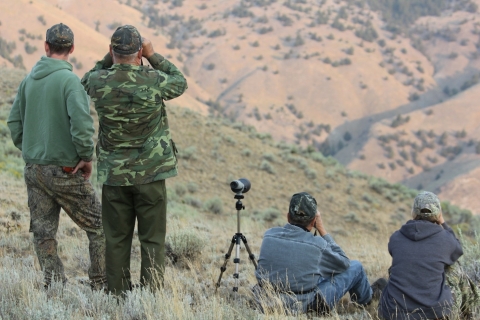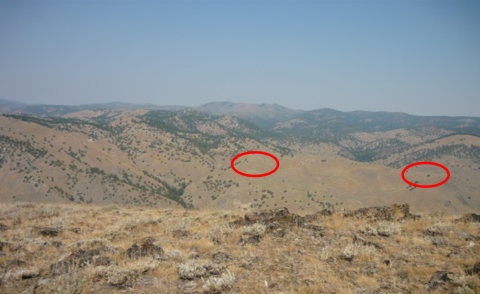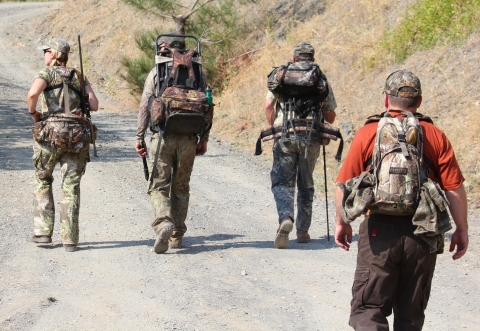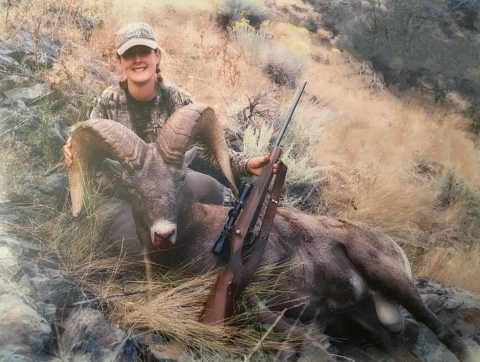Blogger’s note: Marisa Meyer is a U.S. Fish and Wildlife Service Field Supervisor in La Grande, Oregon; endangered species biologist; native Oregonian; wildlife artist; and avid hunting and fishing enthusiast. Marisa had applied for an Oregon bighorn sheep tag since age 12, and was fortunate enough to draw and fill one. Less than 100 tags are available per year and you can only draw this tag once in a lifetime. Marisa takes us on her hunt of a lifetime on public lands operated by the Bureau of Land Management.
Day 1. After much anticipation and preparation, opening day arrived with my stomach full of butterflies. I didn’t get much sleep the night before, but I was ready for the adventure to begin. At sunrise, I spotted the ram I had seen a few weeks before and had hoped to hunt. He had a distinctive size and shape to his curl; the largest ram seen during our scouting trips… and I knew where he had been hanging out.
My ram was in a group of 10, over a mile from our vantage point. I immediately started planning how to get close enough for a good shot. Remaining hidden from 10 sets of sheep eyes would be challenging, but doable given scattered juniper nearby.
It took about an hour to reach the canyon bottom where we started hiking. From there, five of us started up a draw, eventually putting us on top of another ridge to view the herd. By the time we reached the top, it was just my husband and me; the others hung back so as not to spook the rams. We glassed the area where we had originally spotted them. Nothing. We eventually found the herd a half mile from where they were earlier.
The herd had bedded down under the shade of a lone juniper tree. It was difficult to approach with a lack of cover, but a small rock outcrop about 230 yards away provided enough concealment. I positioned myself in those rocks to take a shot if the opportunity arose; my husband was behind me watching through his binoculars. Since the animals were close together, I’d only get a shot if my ram moved away from the others. And so I waited…
….a long 3 ½ hours in 95-degree sun. I was sweaty, anxious, and thirsty but didn’t move to get water for fear I’d miss an opportunity to shoot. In that time, my ram stood up and moved around the tree three different times, but never presented me with a good shot. Finally, he rose, walked a few steps uphill and moved away from the others. He bedded down alone, broadside. I took my rifle safety off and held the crosshairs on his body, just behind his shoulder - my heart was pounding and my hands were shaking. I put my rifle back on safety and leaned back to take a few deep breaths. Then, I took my rifle safety off, held the crosshairs behind his shoulder and squeezed the trigger.
The rams sprang up and ran out of sight in a matter of seconds. As they were running, I put another cartridge in my rifle and watched my ram disappear. He was not limping, there was no blood, and he ran straight uphill effortlessly. I saw the dirt fly up where my bullet had landed below him. I had held too low for my shot. We followed their tracks up, over the ridge, and down the other side, finding no evidence of injury. We didn’t see any of the rams again that day.
Day 2. We set out to look for my ram at sunrise. By sunset, I spotted him again. He was with three others, near where I had shot at him opening day. We watched them bed down and decided to return at daylight the next morning.
Day 3. Three of us hiked up the mountain at dawn. The four rams were still feeding on the same bench as the night before. As we neared, my friend stayed back while my husband and I kept stalking. We were close - only 20 yards away! I hid behind a large rock, unable to get into a shooting position without spooking them. After a few minutes, the rams walked up the mountain, through a rock outcrop and into scattered juniper. Once out of sight, we started to track them.
As we snuck through the trees, we could hear them nearby and suddenly we were caught out in the open. We froze. Two rams spotted us, watched a few minutes, and then returned to grazing. Soon they bedded down under a tree. Once they were out of sight, we moved into position. I found a tree that would provide cover and a solid rest for my rifle. I could only see heads and horns. For a good shot, the rams would have to go out and feed. So again, I waited.
An hour passed and I tried not to think about how I missed him on opening day. I leaned against the juniper with my rifle, ready to shoot the entire time. My husband used his range finder to determine a lone juniper on the edge of the hill was 200 yards away. Given my shooting abilities and preferences, I decided I would only take a shot if my ram presented himself between me and that tree.
Finally, the animals rose and began grazing. My ram was feeding directly across from me, headed toward the 200-yard mark. After what seemed like forever, the ram turned slightly, giving me a broadside view. I placed my crosshairs behind his shoulder - this time I was surprisingly calm- and I squeezed the trigger. As the shot rang out, I put another cartridge in my rifle and prepared for another. The ram jogged around the hillside, while the others ran over the ridge. We tracked my ram up and down, zigzagging along the mountain. There were sheep tracks all over, making it difficult to find him. We found him near the bottom of the canyon. This time my shot hit right where I had aimed.
This was my once in a lifetime hunting experience. I had amazing support from family and friends who were there through the months of anticipation, weeks of scouting, days of shooting practice, and many miles hiked. For me, this hunt was more than just about shooting a big ram. It was the chance to continue our family tradition and share a once in a lifetime hunt with the special people in my life - memories I will cherish for the rest of my life.







